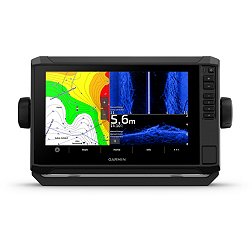Consider the following features to get the best fish finder for your needs.
Portable vs. Permanent vs. Castable
Portable fish finders can go virtually anywhere, making them a great choice for kayak fishing, ice fishing, fly fishing and boat rentals. If you're a boat owner, you may prefer a permanent model that you can mount securely in a convenient location.
If you primarily fish from the shore, you should consider a castable fish finder. These units include a small, castable transducer that attaches to the end of your fishing line. You simply cast your line as you normally would, and the transducer will collect data from the water below and transmit it back to your smartphone or a handheld device, letting you know if your bait is in a productive spot.
Sonar & Transducers
How exactly do fish finders work, anyway? It's all about sonar an acronym for "sound navigation and ranging." The fish finder sends an electronic impulse through a transducer, which the transducer then converts into a sound wave. This wave passes down through the water and through any objects in its path, namely fish and structure. The sound wave ultimately travels back up to the transducer, at which point the fish finder unit will interpret the findings on your screen. Most fish finders sold at DICK'S include the transducer, but check the product details to make sure.
Display Screen
Color screens are the new norm on today's fish finders. A color screen enables you to more easily decipher objects in the water, giving you valuable insight into your game fish. Also consider the amount of pixels on your screen the more pixels, the greater level of detail you can see. LED backlit screens provide brilliant visual display, particularly for fishing in low-light conditions.
GPS
Some fish finders include GPS technology. Most GPS models will allow you to mark your favorite fishing spots and other points of interest so that you can find them quickly and easily. A GPS fish finder also adds an element of safety, allowing you to quickly navigate your way home in the event of an emergency.
Wireless Capability
Many of today's fish finders have wireless capabilities, allowing you to sync the unit with other devices like your phone, laptop, etc. This gives you the ability to view fish finder images from any spot on your boat.
What is CHIRP?
The most advanced fish finders typically feature a relatively new type of sonar called CHIRP Compressed High-Intensity Radiated Pulse. Where traditional fish finders emit one, two or three frequencies, fish finders with CHIRP technology emit a sweeping range of frequencies to provide the user with more information and more detailed imagery.



















































